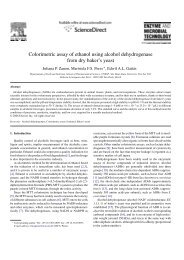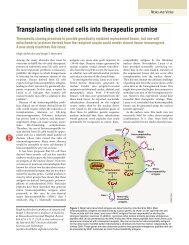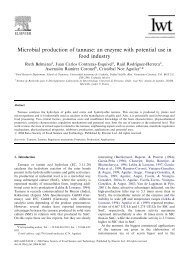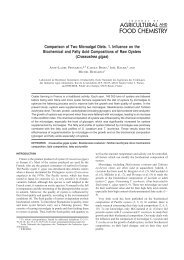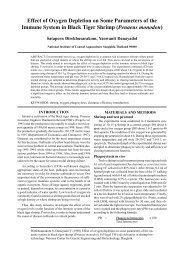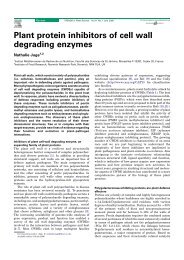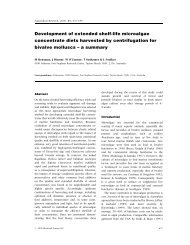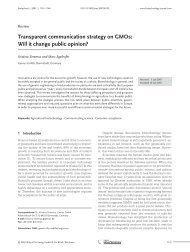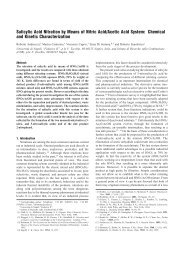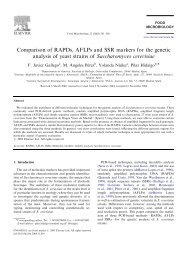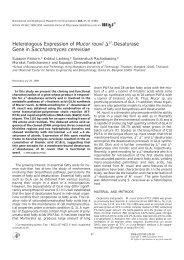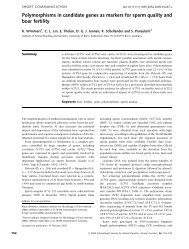Enzymatic microreactors in chemical analysis and kinetic studies
Enzymatic microreactors in chemical analysis and kinetic studies
Enzymatic microreactors in chemical analysis and kinetic studies
Create successful ePaper yourself
Turn your PDF publications into a flip-book with our unique Google optimized e-Paper software.
the hydrolysis of p-nitrophenylphosphate <strong>and</strong> urea catalyzed<br />
by alkal<strong>in</strong>e phosphatase <strong>and</strong> urease, respectively.<br />
Yadavalli et al. (2004) presented a microarray-based<br />
system with immobilized enzymes which enabled<br />
screen<strong>in</strong>g of low concentrations of enzyme substrates.<br />
The hydrogel arrays were prepared photolithographically<br />
on silicon surfaces. In earlier work, Zhan et al.<br />
(2002) developed a similar method for the monitor<strong>in</strong>g<br />
of the reactions catalyzed by glucose oxidase <strong>and</strong><br />
horseradish peroxidase entrapped <strong>in</strong> a hydrogel matrix<br />
(Fig. 5). The oxidation of glucose was followed by<br />
decomposition of Amplex red dye (a substrate of horseradish<br />
peroxidase) which resulted <strong>in</strong> formation of fluorescent<br />
resoruf<strong>in</strong>. It was concluded that the pores <strong>in</strong> the<br />
hydrogels were sufficiently small to reta<strong>in</strong> the enzymes<br />
<strong>and</strong> the reporter dyes, <strong>and</strong> it was suggested that the<br />
method could be applied to immobilization <strong>and</strong> monitor<strong>in</strong>g<br />
of reactions of other prote<strong>in</strong>s.<br />
Recently Rondelez et al. (2005) managed to follow<br />
the reaction catalyzed by s<strong>in</strong>gle molecules of h-galactosidase<br />
<strong>and</strong> horseradish peroxidase entrapped between<br />
glass/PDMS slides, <strong>in</strong> a non-microfluidic system. This<br />
was facilitated by a fluorescence assay <strong>and</strong> watch<strong>in</strong>g<br />
the product detection with<strong>in</strong> a few m<strong>in</strong>utes.<br />
Any k<strong>in</strong>d of biocatalysis imag<strong>in</strong>g <strong>in</strong> enzymatic<br />
<strong>microreactors</strong> is dependent on the existence of appropriate<br />
assays, usually <strong>in</strong>volv<strong>in</strong>g fluorescence spectrometry.<br />
UV-Vis imag<strong>in</strong>g is possible <strong>in</strong> pr<strong>in</strong>ciple, but would<br />
require the use of channels <strong>and</strong> supports made of a<br />
material such as silica which is transparent over the<br />
wavelength range used.<br />
Fig. 5. Micrographs of hydrogel micropatches with<strong>in</strong> a microfluidic<br />
channel: (A) optical micrograph; (B) fluorescence micrograph of the<br />
same micropatches shown <strong>in</strong> (A). Fluorescence arises from the dye<br />
SNAFL-1 entrapped with<strong>in</strong> the hydrogel. Repr<strong>in</strong>ted with permission<br />
from Zhan et al. (2002). Copyright (2002) American Chemical<br />
Society.<br />
3. Conclusions <strong>and</strong> future trends<br />
So far, very few enzymes have been applied with<strong>in</strong><br />
<strong>microreactors</strong>, although it seems the new devices will be<br />
developed not only as model systems but they will also<br />
be directed to specific problems, as already happens <strong>in</strong><br />
the case of tryptic digestion <strong>and</strong> PCR <strong>microreactors</strong>.<br />
There are few published patents describ<strong>in</strong>g construction<br />
of enzymatic <strong>microreactors</strong> (Fujii <strong>and</strong> Hosokawa, 1998;<br />
Combette <strong>and</strong> Constant<strong>in</strong>, 2003; Miyazaki <strong>and</strong> Maeda,<br />
2004a,b), which <strong>in</strong>dicates that developments of applications<br />
<strong>in</strong> this field are still <strong>in</strong> the <strong>in</strong>itial stage.<br />
One applications-oriented example of use of enzymatic<br />
<strong>microreactors</strong> is the hydrolysis of used grease <strong>and</strong><br />
its conversion to diesel fuel (Hsu et al., 2002). This also<br />
po<strong>in</strong>ts to the bgreenQ aspects of <strong>microreactors</strong>, due to<br />
their low ma<strong>in</strong>tenance requirements, as well as applications<br />
<strong>in</strong> environmental protection. There is a huge commitment<br />
by the pharmaceutical <strong>in</strong>dustry to the search for<br />
new potent <strong>in</strong>hibitors of lipases, that can be employed <strong>in</strong><br />
the treatment of obesity (Müller <strong>and</strong> Petry, 2004), <strong>and</strong><br />
fast analytical procedures for these biocatalysts are required.<br />
A variety of immobilized lipases available from<br />
a range of suppliers (e.g. Sigma Aldrich, Amano, Bio-<br />
Chemika, Novozymes) may be used <strong>in</strong> microsystems<br />
produced for fast screen<strong>in</strong>g of <strong>in</strong>hibitors of these<br />
enzymes. Other immobilized enzymes are already<br />
used <strong>in</strong> <strong>in</strong>dustrial syntheses (Buchholz et al., 2005).<br />
Various aspects of enzyme immobilization <strong>in</strong>clud<strong>in</strong>g<br />
stability issues have been discussed by Cao (2005).<br />
<strong>Enzymatic</strong> <strong>microreactors</strong> have the potential for <strong>in</strong>troduction<br />
<strong>in</strong>to <strong>in</strong>dustrial-scale synthesis. They can be<br />
easily <strong>in</strong>corporated <strong>in</strong> systems operat<strong>in</strong>g <strong>in</strong> the external<br />
number<strong>in</strong>g-up mode, where the reaction subunits are<br />
cased separately <strong>and</strong> put together externally. This<br />
mode of scal<strong>in</strong>g up reactions provides good adjustability<br />
<strong>and</strong> control over the process, due to repetition of the<br />
fluidic path while the transport properties <strong>and</strong> hydrodynamics<br />
are preserved (Hessel et al., 2004). Any microreactor<br />
units conta<strong>in</strong><strong>in</strong>g enzyme found to be lack<strong>in</strong>g<br />
sufficient activity can be easily replaced with new<br />
ones, with m<strong>in</strong>imal effects on the performance of the<br />
whole system.<br />
The s<strong>in</strong>e qua non-condition for any large scale use of<br />
enzymatic <strong>microreactors</strong> is of ease of use <strong>and</strong> robustness,<br />
together with commercialization of microsystem<br />
components. Robustness <strong>in</strong> part governed by the enzyme<br />
stability, <strong>and</strong> lipases have the advantages of<br />
stability at ambient temperatures whether immobilized<br />
<strong>and</strong> stored dry or <strong>in</strong> an organic solvent.<br />
The other important issue is sett<strong>in</strong>g up the <strong>in</strong>terface<br />
systems to operate the <strong>microreactors</strong>. Such systems




